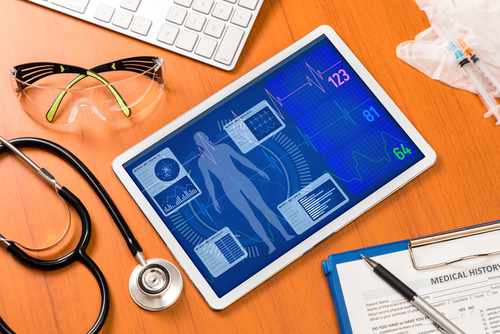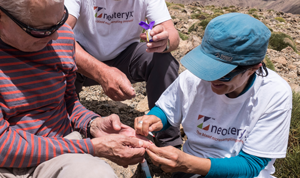Share this
a brief history on the remote patient monitoring system
by Neoteryx Microsampling on Jan 15, 2019 5:15:00 AM
The remote patient monitoring as we know it started when the first two physicians consulted over a telephone, probably in the 1800s. (Consultations may have been carried out by smoke signals and heliograph before the telegraph, but there is no documentation.)

1924 |
A speculative cover of Radio News magazine showed the use of the radio for medical consultation. |
1948 |
Technology advanced and one doctor sent X-ray images over telephone wires to another doctor in Pennsylvania. |
1959 |
Neurological exams are now being electronically transmitted for consultation. |
1960 |
Psychiatric consultations are now being transmitted by closed-circuit television. |
Then came the ultimate in remote monitoring - space. Alan Shepard flew the spacecraft Freedom 7, becoming the first American in space in May 1961. The only monitoring available was a primitive EKG, a respiration sensor in his microphone and a thermometer. His physicians relied mainly on his preflight exams and his voice, as well as his own evaluations in flight.
A blood pressure monitoring device was developed for the orbital flights, but the astronaut didn't turn on the system on the first flight, and the machine was not properly calibrated on the second. On the last two Mercury missions, the BP monitor worked perfectly.
In 1967 physicians started transmitting EKGs over telephone wires.
In the 1970s a remote monitoring program was developed to oversee healthcare at what was then called the Papago Indian Reservation in Arizona. The sponsors of the program were Kaiser Foundation and Lockheed. The program experienced numerous problems and was discontinued in 1977, but NASA used the knowledge gained to improve their space technology.
By 1980 transmitting X-ray images became routine. The field shifted in the 1990s with the development of the internet. The internet explosion left old-school telemedicine behind. Not until the broadband infrastructure became available did telemedicine take off.
Now remote monitoring means more than just telecommunicated examinations and consultations, more than sending X-rays and CT and MRI scans and lab data. Now patients can stay in their own homes and still receive quality healthcare.

Even blood work can now be done remotely by a technique called microsampling which requires only a drop of blood from a fingerstick. The blood is collected and sent to the laboratory by mail, eliminating long drives and painful blood drawing at the lab. Life is getting easier for many patients through the technology of remote monitoring.

Share this
- Microsampling (206)
- Research, Remote Research (119)
- Venipuncture Alternative (105)
- Clinical Trials, Clinical Research (83)
- Mitra® Device (73)
- Therapeutic Drug Monitoring, TDM (51)
- Dried Blood Spot, DBS (39)
- Biomonitoring, Health, Wellness (30)
- Infectious Disease, Vaccines, COVID-19 (24)
- Blood Microsampling, Serology (23)
- Omics, Multi-Omics (21)
- Decentralized Clinical Trial (DCT) (20)
- Specimen Collection (18)
- Toxicology, Doping, Drug/Alcohol Monitoring, PEth (17)
- Skin Microsampling, Microbiopsy (14)
- hemaPEN® Device (13)
- Preclinical Research, Animal Studies (12)
- Pharmaceuticals, Drug Development (9)
- Harpera Device (7)
- Industry News, Microsampling News (5)
- Antibodies, MAbs (3)
- Company Press Release, Product Press Release (3)
- Environmental Toxins, Exposures (1)
- July 2025 (1)
- May 2025 (1)
- April 2025 (2)
- December 2024 (2)
- November 2024 (1)
- October 2024 (3)
- September 2024 (1)
- June 2024 (1)
- May 2024 (1)
- April 2024 (4)
- March 2024 (1)
- February 2024 (2)
- January 2024 (4)
- December 2023 (3)
- November 2023 (3)
- October 2023 (3)
- September 2023 (3)
- July 2023 (3)
- June 2023 (2)
- April 2023 (2)
- March 2023 (2)
- February 2023 (2)
- January 2023 (3)
- December 2022 (2)
- November 2022 (3)
- October 2022 (4)
- September 2022 (3)
- August 2022 (5)
- July 2022 (2)
- June 2022 (2)
- May 2022 (4)
- April 2022 (3)
- March 2022 (3)
- February 2022 (4)
- January 2022 (5)
- December 2021 (3)
- November 2021 (5)
- October 2021 (3)
- September 2021 (3)
- August 2021 (4)
- July 2021 (4)
- June 2021 (4)
- May 2021 (4)
- April 2021 (3)
- March 2021 (5)
- February 2021 (4)
- January 2021 (4)
- December 2020 (3)
- November 2020 (5)
- October 2020 (4)
- September 2020 (3)
- August 2020 (3)
- July 2020 (6)
- June 2020 (4)
- May 2020 (4)
- April 2020 (3)
- March 2020 (6)
- February 2020 (3)
- January 2020 (4)
- December 2019 (5)
- November 2019 (4)
- October 2019 (2)
- September 2019 (4)
- August 2019 (4)
- July 2019 (3)
- June 2019 (7)
- May 2019 (6)
- April 2019 (5)
- March 2019 (6)
- February 2019 (5)
- January 2019 (8)
- December 2018 (3)
- November 2018 (4)
- October 2018 (7)
- September 2018 (6)
- August 2018 (5)
- July 2018 (8)
- June 2018 (6)
- May 2018 (5)
- April 2018 (6)
- March 2018 (4)
- February 2018 (6)
- January 2018 (4)
- December 2017 (2)
- November 2017 (3)
- October 2017 (2)
- September 2017 (4)
- August 2017 (2)
- July 2017 (4)
- June 2017 (5)
- May 2017 (6)
- April 2017 (6)
- March 2017 (5)
- February 2017 (4)
- January 2017 (1)
- July 2016 (3)
- May 2016 (1)
- April 2016 (2)


No Comments Yet
Let us know what you think